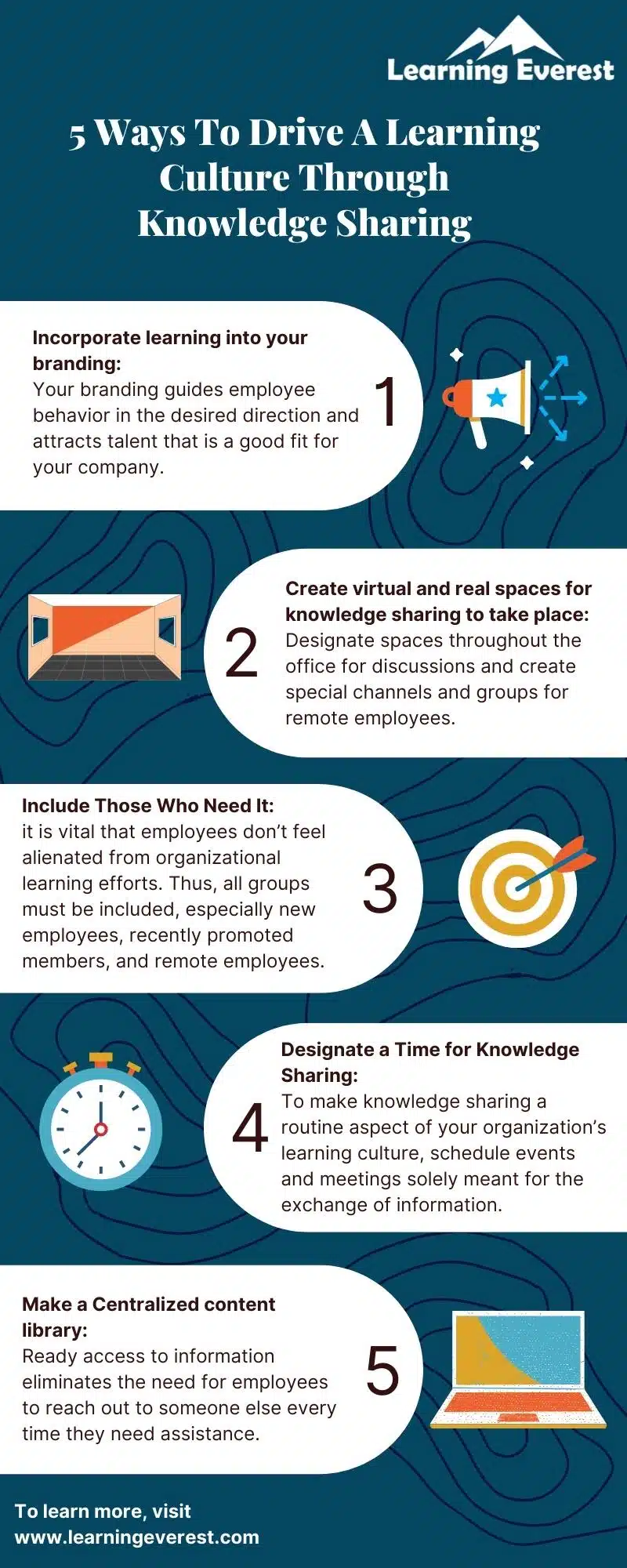A learning culture is an organizational mindset of continuous acquisition and sharing of information among employees and departments. Knowledge sharing, which is the exchange of information among people and entities, drives learning cultures further. In learning cultures, knowledge and information are valuable community resources that level the playing field for employees and develop overall organizational competence. Knowledge sharing in a learning culture also allows for more internal hiring, thereby resulting in greater employee retention. Saving costs on hiring then opens up space for the business to invest in other operations. In this article, we will go over 5 tips that will help you drive an organizational learning culture through knowledge sharing.
Table of Contents
Tips for Easy Knowledge Sharing
No. 1: Incorporate Learning into your Branding
One way to facilitate knowledge sharing in a learning culture is to make learning a part of your brand. Doing so attracts applications from people with similar work values. A good culture fit ensures that new hires easily align with organizational values and goals.
Another benefit of using branding to promote a learning culture and knowledge sharing is that it creates momentum over time. Since building a brand requires internal alignment with said branding, a good strategy slowly shifts employees’ behaviors and values in the desired direction. This would mean that they set examples for new hires and readily open up channels of knowledge sharing with them as a result.
Repeated cycles of such interactions create a tradition of knowledge sharing making it a routine aspect of an organizational learning culture.
No. 2: Create Virtual and Real Spaces for Knowledge Sharing to Take Place
An office is a busy environment but learning takes some peace and quiet. Often, employees need space to brainstorm, plan, and ideate. For such instances, it is a good idea to designate spaces throughout the office that are specially reserved for such sessions where peers, subordinates, and seniors can sit and discuss ideas.
These could be break rooms, lounges, meeting rooms, and conference halls. Leave access to such places open and trust your employees to use them well.
For remote employees and workforces, you can create designated channels for different projects and some common channels for the purpose of general knowledge sharing. You can also add dashboards and news feeds to your LMS to meet this purpose. It is essential that in-office employees also remain involved in these remote employee spaces so as not to create two separate knowledge factions within your organization.
No. 3: Include Those Who Need it Most
Carrying on the thought from the previous point, it is vital that employees don’t feel alienated from organizational learning efforts. Thus, in a learning culture, all groups must be included.
This is easier said than done, however, as it is natural for there to be groups that feel a little lost when it comes to knowledge sharing. These usually include:
- New employees
- Employees who have just been promoted or switched departments
- Remote employees who have very little physical contact with those they work with
L&D departments and HR should pay special attention to these groups and offer them extra help while they adjust.
One of the most effective ways to include these sections of your workforce in knowledge sharing is by assigning mentors to them. A mentor can assist these employees to navigate novelty, offer their expertise, and help them network as newbies in the organization or in a role.
Such mentors can also serve as models for how knowledge sharing typically takes place in the business, thereby breaking them in. There is a huge loss to the organization if the knowledge is not shared. This report provides greater details.
No. 4: Designate Time for Knowledge Sharing
To make knowledge sharing a routine aspect of your organization’s learning culture, schedule events and meetings solely meant for the exchange of information.
Some examples are weekly round-ups and retrospective meetings.
If designated meet ups are not always feasible, you can opt for digital options like newsletters, blog-posts, and real or virtual bulletin boards where employees can share their experiences.
No. 5: Make a Centralized Content Library
The last tip for knowledge sharing is to make content easily accessible. Ready access to information eliminates the need for employees to reach out to someone else every time they need assistance. This quickens personal learning but also turns them into a readily available resource for sharing that information with others.
Content libraries, thus, promote a learning culture and increase the number of skilled employees within the organization.
The most convenient tool for a centralized content library is an LMS where learners can search up and access the material they need. You can host microlearning courses, gamified learning, and full-fledged e-learning modules on these platforms and track usage statistics. However, organizations can also build internal wikis, use a cloud drive, and even opt for a physical library if they wish to.
Infographics

Drive Learning Culture Through Knowledge Sharing – 5 Critical Ways – Infographics





